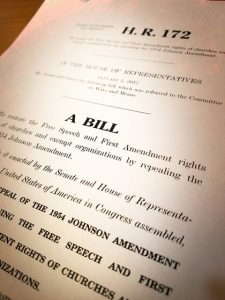Connecting Tax Policy to Human Services
October 5, 2017Last week, the White House and Republican leaders released a policy framework for overhauling the tax code. Congress is now moving into the process of fleshing out the details of that framework, with the goal of passing a tax package this year. The connection between tax policy and human services is a complicated story to tell and is one that will benefit greatly from relying on research-based communication strategies. In our February 23 newsletter, we focused on recommendations for framing budget and tax issues from our friends at the FrameWorks Institute.
 This week, we’re highlighting NHSA’s “Protect Nonprofit Nonpartisanship” piece, which was developed to build support for retaining the Johnson Amendment. The Johnson Amendment is a policy within the tax code that establishes nonprofits as nonpartisan organizations. It ensures that nonprofits will not influence, nor be influenced by, partisan politics, and is widely supported by the broader nonprofit sector. President Trump has expressed support for rolling back this protection, potentially as part of tax legislation.
This week, we’re highlighting NHSA’s “Protect Nonprofit Nonpartisanship” piece, which was developed to build support for retaining the Johnson Amendment. The Johnson Amendment is a policy within the tax code that establishes nonprofits as nonpartisan organizations. It ensures that nonprofits will not influence, nor be influenced by, partisan politics, and is widely supported by the broader nonprofit sector. President Trump has expressed support for rolling back this protection, potentially as part of tax legislation.
Below, we walk through how NHSA applied the Building Well-Being Narrative to the piece in order to provide a clear explanation of what’s at stake with this policy proposal, not just for the sector, but for society. Stay tuned for additional tips and resources from us as the tax debate unfolds.
Excerpts from “Protect Nonprofit Nonpartisanship”
Step 1: Establish why the public should care about human services.
The organizations that comprise the human service sector share a common mission: to help make sure everyone can reach their full potential and contribute to our communities in meaningful ways.
We know from FrameWorks’ research that leading with the Value of Human Potential in our communications helps the public understand that human services are important to everyone.
“Values are enduring beliefs, which orient individuals’ attitudes and behavior. Effective values form the basis for social appeals that pull audiences’ reactions in a desirable direction.”
—Talking Human Services: A FrameWorks MessageMemo
Step 2: Explain what human services do.
The sector provides the elements and materials that build individual well-being–everything from access to social relationships, to opportunities for young people to play and learn, to places for people with disabilities or mental illness to receive the support they need to live independently. Human services ensure that all individuals have what they need to do well socially, emotionally, financially, and physically and to engage in our communities.
The public doesn’t know much about human services, and that limits their engagement as advocates for the sector. Using the Construction Metaphor to explain how human services build, maintain, and restore well-being provides the public with a more complete and accurate picture of the sector’s role in communities across the country.
Step 3: Explain how the Johnson Amendment strengthens the human services sector.
We know that our sector is most effective when our resources are focused on mission-related work, not distracted by political campaigns. Like the walls of a house, the Johnson Amendment protects nonprofits from the ever-shifting political winds by keeping partisan campaigns outside the scope of our advocacy work. We should continue to be strong advocates for the issues that affect our communities, but without the pressure to become involved in partisan politics.
Extending the Construction Metaphor helps to explain what the Johnson Amendment does and why it is important. You may be tempted to skip Steps 1 and 2 and go directly to Step 3. Do not give in to that temptation. FrameWorks’ research demonstrated that starting communications with the Value of Human Potential and using the Construction Metaphor to provide a general explanation of human services increases the public’s support for, and understanding of, the sector. Without this context, the public will struggle to interpret what a given policy or proposal means and why they should care.
Step 4. Explain the impact of repealing the Johnson Amendment.
Weakening the Johnson Amendment will create pressure on nonprofits to divert resources to political campaigns, identify with a political party, and accept funding that is conditioned on supporting or opposing specific candidates. It is, therefore, important that the protections against participation in political campaign activities remain intact, leaving organizations free to focus on their missions.
The last step explains how repealing the Johnson Amendment will undermine human services, and by extension, the communities they serve.

